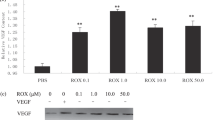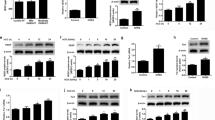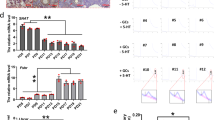Abstract
Angiogenesis, the growth of new blood vessels, occurs normally in female reproductive organs. We tested the hypothesis that angiogenesis inhibition may affect fertility by studying the reproductive system in either pregnant or nonpregnant cycling mice after treatment with the angiogenesis inhibitor AGM-1470. Administration of AGM-1470 to pregnant mice resulted in complete failure of embryonic growth due to interference with decidualization, placental and yolk sac formation, and embryonic vascular development. When nonpregnant cycling female mice were chronically treated with AGM-1470, inhibition of endometrial maturation and corpora lutea was observed. These data suggest that processes in reproduction can be controlled through angiogenesis inhibition.
This is a preview of subscription content, access via your institution
Access options
Subscribe to this journal
Receive 12 print issues and online access
$209.00 per year
only $17.42 per issue
Buy this article
- Purchase on Springer Link
- Instant access to full article PDF
Prices may be subject to local taxes which are calculated during checkout
Similar content being viewed by others
References
Folkman, J. & Klagsbrun, M. Angiogenic factors. Science 235, 442–447 (1987).
Reynolds, L.P., Killilea, S.D. & Redmer, D.A. Angiogenesis in the female reproductive system. FASEB J. 6, 886–892 (1992).
Poole, T.J. & Coffin, J.D. Vasculogenesis and angiogenesis — two distinct morphogenetic mechanisms establish embryonicvascular pattern. J. Exp. Zool. 251, 224–231 (1989).
Folkman, J. What is the evidence that tumors are angiogenesis dependent? J. Natl. Cancer Inst. 82, 4–6 (1989).
Michaelson, I.C. The mode of development of the vascular system of the retina, with some observations on its significance for certain retinal disease. Trans. Ophthalmol. Soc. UK 68 137–180 (1948).
Engerman, R.L., Pfaffenbach, D. & Davis, M.D. Cell turnover of capillaries. Lab. Invest. 17, 738–743 (1967).
Christenson, L.K. & Stouffer, R.L. Proliferation of microvascular endothelial cells in the primate corpus luteum during the menstrual cycle and simulated early pregnancy. Endocrinol. 137, 367–374 (1996).
Goodger, A.M., Rogers, P.A. Uterine endothelial proliferation before and after embryo implantation. J. Reprod. Fertility 99, 451–457 (1993).
Tamura, H. & Greenwald, G.S. Angiogenesis and its hormonal control in the corpus luteum of the pregnant rat. Biol. Reprod. 36, 1149–1154 (1987).
Welch, A.O. & Enders, A.C. Chorioallantoic placenta formation in the rat: Angiogenesis and maternal blood circulation in the mesometrial region of the implantation chamber prior to placenta formation. Am. J. Anat. 192, 347–365 (1991).
Ingber, D. et al. Synthetic analogues of fumagillin that inhibit angiogenesis and suppress tumor growth. Nature 348, 555–557 (1990).
Champlin, A.K., Dorr, D.L. & Gates, A.H. Determining the stage of the estrous cycle in the mouse by the appearance of the vagina. Biol. Reprod. 8, 491–494 (1973).
Schlaeger, T.M., Qin, Y., Fujiwara, Y., Magram, J. & Sato, T.N. Vascular endothelial cell lineage-specific promoter in transgenic mice. Development 121, 1089–1098 (1995).
Author information
Authors and Affiliations
Rights and permissions
About this article
Cite this article
Klauber, N., Rohan, R., Flynn, E. et al. Critical components of the female reproductive pathway are suppressed by the angiogenesis inhibitor AGM-1470. Nat Med 3, 443–446 (1997). https://doi.org/10.1038/nm0497-443
Received:
Accepted:
Issue Date:
DOI: https://doi.org/10.1038/nm0497-443
This article is cited by
-
The endometrial transcriptome transition preceding receptivity to embryo implantation in mice
BMC Genomics (2023)
-
A 3D “sandwich” co-culture system with vascular niche supports mouse embryo development from E3.5 to E7.5 in vitro
Stem Cell Research & Therapy (2023)
-
Estrogen Regulates Endoplasmic Reticulum Stress–Mediated Apoptosis by ERK-p65 Pathway to Promote Endometrial Angiogenesis
Reproductive Sciences (2021)
-
H19 regulates angiogenic capacity of extravillous trophoblasts by H19/miR-106a-5p/VEGFA axis
Archives of Gynecology and Obstetrics (2020)
-
Chronic effects of an anti-angiogenic thrombospondin-1 mimetic peptide, ABT-898, on female mouse reproductive outcomes
Reproductive Biology and Endocrinology (2016)



